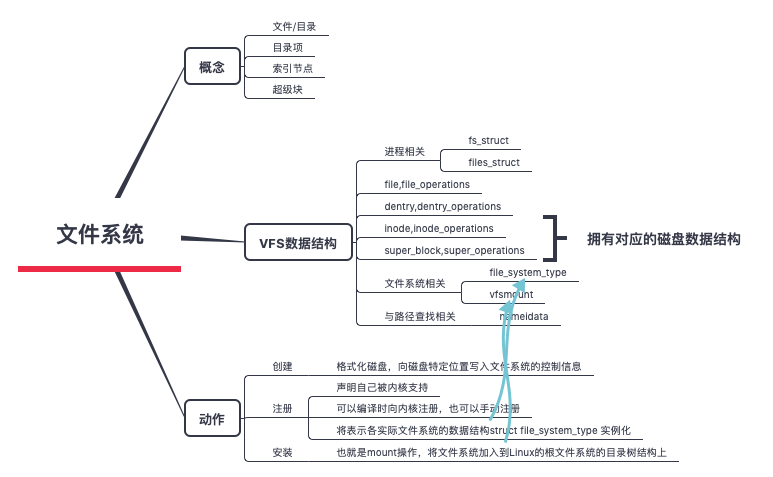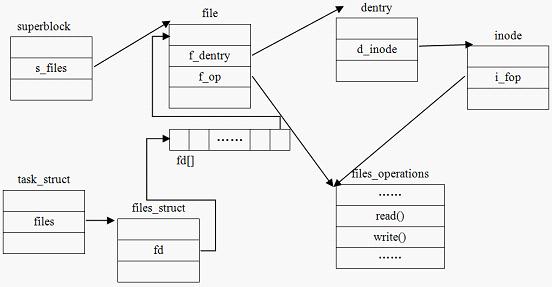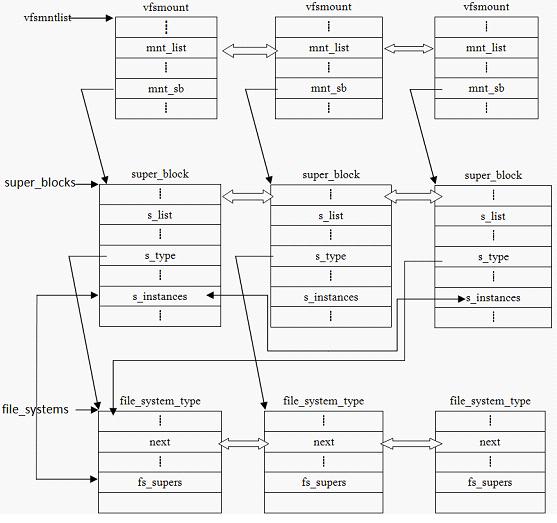简介
许式伟:怎么让很多的软件进程同时使用这些外置存储设备,而不会乱呢?直接基于物理的存储地址进行读写肯定是行不通的,过上几个月你自己可能都不记得什么数据写到哪里了。所以和内存管理不同,外部存储的管理,我们希望这些写到存储中的数据是“自描述”的某种数据格式,我们可以随时查看之前写了哪些内容,都什么时候写的。这就是文件系统的来源。
许式伟:存储它不应该只能保存一个文件,而是应该是多个。既然是多个,就需要组织这些文件。那么,怎么组织呢?操作系统的设计者们设计了文件系统这样的东西,来组织这些文件。虽然文件系统的种类有很多(比如:FAT32、NTFS、EXT3、EXT4 等等),但是它们有统一的抽象:文件系统是一颗树;节点要么是目录,要么是文件;文件必然是叶节点;根节点是目录,目录可以有子节点。
vfs 数据结构 / 两个关系

进程与超级块、文件、索引结点、目录项的关系

linux系统的进程结构体有以下几个字段
struct task_struct {
...
struct m_inode * pwd;
struct m_inode * root;
struct m_inode * executable; //进程对应可执行文件的i节点
...
/* Filesystem information: */
struct fs_struct *fs;
/* Open file information: */
struct files_struct *files;
...
}
struct files_struct {//打开的文件集
atomic_t count; /*结构的使用计数*/
……
int max_fds; /*文件对象数的上限*/
int max_fdset; /*文件描述符的上限*/
int next_fd; /*下一个文件描述符*/
struct file ** fd; /*全部文件对象数组*/
……
};
struct fs_struct {//建立进程与文件系统的关系
atomic_t count; /*结构的使用计数*/
rwlock_t lock; /*保护该结构体的锁*/
int umask; /*默认的文件访问权限*/
struct dentry * root; /*根目录的目录项对象*/
struct dentry * pwd; /*当前工作目录的目录项对象*/
struct dentry * altroot; /*可供选择的根目录的目录项对象*/
struct vfsmount * rootmnt; /*根目录的安装点对象*/
struct vfsmount * pwdmnt; /*pwd的安装点对象*/
struct vfsmount * altrootmnt;/*可供选择的根目录的安装点对象*/
};
超级块、安装点和具体的文件系统的关系
linux 和 windows 一个很大区别就是,window 有c盘、d盘等,而linux 则都是从根目录开始,好像只有一个磁盘一样。为了实现这个效果,linux 就要引入vfsmount 等概念。

- 被Linux支持的文件系统,都有且仅有一个file_system_type结构
- 每安装一个文件系统,就对应有一个超级块和安装点
文件访问
查找时,在遍历路径的过程中,会逐层地将各个路径组成部分解析成目录项对象,如果此目录项对象在目录项缓存中,则直接从缓存中获得;如果该目录项在缓存中不存在,则进行一次实际的读盘操作,从磁盘中读取该目录项所对应的索引节点。得到索引节点后,则建立索引节点与该目录项的联系。如此循环,直到最终找到目标文件对应的目录项,也就找到了索引节点,这样就建立了文件对象与实际的物理文件的关联。

文件对象所对应的文件操作函数 列表是通过索引结点的域i_fop得到的
mount 过程
一个磁盘如何被使用?
insmod xx.ko加载块设备驱动mknod /dev/xx type major minor创建设备文件,实质将文件操作与设备驱动程序关联,对于字符设备,操作/dev/xx便是读写字符设备了,对于块设备,会复杂一点。- 例如,
mount -t ext3 /dev/sdb /mnt/alan,/dev/sdb块设备被mount到/mnt/alan目录。
那么mount 如何实现这个神奇的效果呢?mount系统调用 入口
SYSCALL_DEFINE5(mount, char __user *, dev_name, char __user *, dir_name, char __user *, type, unsigned long, flags, void __user *, data){
......
ret = do_mount(kernel_dev, dir_name, kernel_type, flags, options);
......
}
接下里的调用链:do_mount->do_new_mount
static int do_new_mount(struct path *path, const char *fstype, int flags,
int mnt_flags, const char *name, void *data)
{
...
mnt = vfs_kern_mount(type, flags, name, data);
...
err = do_add_mount(real_mount(mnt), path, mnt_flags);
...
}
do_new_mount()函数主要分成两大部分:
- 建立vfsmount对象和superblock对象,必要时从设备上获取文件系统元数据;
- 将vfsmount对象加入到mount树和Hash Table中,并且将原来的dentry对象无效掉。
/dev/sdb被mount之后,用户想要访问该设备上的一个文件ab.c,假设该文件的地址为:/mnt/alan/ab.c。
- 在打开该文件的时候,首先需要进行path解析。
- 在解析到
/mnt/alan的时候,得到/mnt/alan的dentry目录项,并且发现该目录项已经被标识为DCACHE_MOUNTED。 - 之后,会采用
/mnt/alan计算HASH值去检索VFSMOUNT Hash Table,得到对应的vfsmount对象。 - 然后采用vfsmount指向的mnt_root目录项替代
/mnt/alan原来的dentry,从而实现了dentry和inode的重定向。 - 在新的dentry的基础上,解析程序继续执行,最终得到表示ab.c文件的inode对象。
总结一下就是:Mount Point DefinitionThe mount point becomes the root directory of the newly added filesystem, and that filesystem becomes accessible from that directory.
vfs_kern_mount
struct vfsmount *
vfs_kern_mount(struct file_system_type *type, int flags, const char *name, void *data){
......
mnt = alloc_vfsmnt(name);
......
// 从文件系统中读取超级块
root = mount_fs(type, flags, name, data);
......
mnt->mnt.mnt_root = root;
mnt->mnt.mnt_sb = root->d_sb;
mnt->mnt_mountpoint = mnt->mnt.mnt_root;
mnt->mnt_parent = mnt;
list_add_tail(&mnt->mnt_instance, &root->d_sb->s_mounts);
return &mnt->mnt;
}
struct dentry * mount_fs(struct file_system_type *type, int flags, const char *name, void *data)
{
struct dentry *root;
struct super_block *sb;
char *secdata = NULL;
int error = -ENOMEM;
...
root = type->mount(type, flags, name, data);
...
sb = root->d_sb;
...
}
- alloc_vfsmnt,vfs_kern_mount 先是创建 struct mount 结构,内部包含一个vfsmount 结构
- mount_fs,mount_fs()函数中会调用特定文件系统的mount方法,对于
/dev/sdb设备上的ext3文件系统,ext3_mount–> mount_bdev,Mount_bdev()函数主要完成superblock对象的内存初始化,并且加入到全局superblock链表中。 - Vfsmount中的mnt_root指向superblock对象的s_root根目录项。
相关的数据结构
struct mount {
struct hlist_node mnt_hash;
struct mount *mnt_parent; // 装载点所在的父文件系统
struct dentry *mnt_mountpoint; // 装载点在父文件系统中的dentry
struct vfsmount mnt;
union {
struct rcu_head mnt_rcu;
struct llist_node mnt_llist;
};
struct list_head mnt_mounts; /* list of children, anchored here */
struct list_head mnt_child; /* and going through their mnt_child */
struct list_head mnt_instance; /* mount instance on sb->s_mounts */
const char *mnt_devname; /* Name of device e.g. /dev/dsk/hda1 */
struct list_head mnt_list;
......
} __randomize_layout;
struct vfsmount {
struct dentry *mnt_root; // 当前文件系统根目录的dentry
struct super_block *mnt_sb; // 指向超级块的指针
int mnt_flags;
} __randomize_layout;
do_add_mount
do_add_mount–> graft_tree–> attach_recursive_mnt
将创建的vfsmount对象加入到mount树和VFSMOUNT Hash Table中,并且将老的dentry目录项标识成DCACHE_MOUNTED,一旦dentry被标识成DCACHE_MOUNTED,也就意味着在访问路径上对其进行了屏蔽。
挂载方式
如果将mount的过程理解为:inode被替代的过程。除了将设备mount到rootfs上,根据被替代方式的不同,mount的花样可多了。
bind mount
mount –bind olddir newdir
ln分为软链接和硬链接
硬链接只能连文件 你删除它源文件就被删了
软链接相当于windows的快捷方式,文件和目录都可以连,但是你删出它只是删除的这个快捷方式
在操作系统中ln -s和mount -bind也许使用起来没多少差别,但是ftp目录里貌似不能放软连接。把一个文件夹mount到另一个地方,等于在把它挂载到那个地方当成一个磁盘,进到两个文件夹中操作 都是等价的,删除一个文件也会在两边同时删除。
union mount
联合文件系统是一种 堆叠文件系统,通过不停地叠加文件实现对文件的修改。其中,增加操作通过在读写层增加新文件实现,删除操作一般通过添加额外的删除属性文件实现,比如删除a.file时读写层增加一个a.file.delete文件。修改只读层文件时,需要先复制一份儿文件到读写层,然后修改复制的文件。
参见Union mount,In computer operating systems, union mounting is a way of combining multiple directories into one that appears to contain their combined contents.
union mount的使用场景——读写只读文件系统,As an example application of union mounting, consider the need to update the information contained on a CD-ROM or DVD. While a CD-ROM is not writable, one can overlay the CD’s mount point with a writable directory in a union mount. Then, updating files in the union directory will cause them to end up in the writable directory, giving the illusion that the CD-ROM’s contents have been updated.
Union FileSystem的核心逻辑是Union Mount,它支持把一个目录A和另一个目录B union,提供一个虚拟的C目录(目录union的语义)。对于特定的权限设置策略,如果设置A目录可写,B目录只读。用户对目录C的读取就是A加上B的内容,而对C目录里文件写入和改写则会保存在目录A上。这样,就有了A在B上层的感觉。 DOCKER基础技术:AUFS
rootfs
rootfs是基于内存的文件系统,所有操作都在内存中完成;也没有实际的存储设备,所以不需要设备驱动程序的参与。基于以上原因,Linux在启动阶段使用rootfs文件系统。
参见https://www.kernel.org/doc/Documentation/filesystems/ramfs-rootfs-initramfs.txt
What is initramfs?
All 2.6 Linux kernels contain a gzipped “cpio” format archive, which is extracted into rootfs when the kernel boots up. After extracting, the kernel checks to see if rootfs contains a file “init”, and if so it executes it as PID
- If found, this init process is responsible for bringing the system the rest of the way up, including locating and mounting the real root device (if any). If rootfs does not contain an init program after the embedded cpio archive is extracted into it, the kernel will fall through to the older code to locate and mount a root partition, then exec some variant of /sbin/init out of that.
所以一个linux的启动过程经历了rootfs ==> 挂载initramfs ==> 挂载磁盘上的真正的fs
